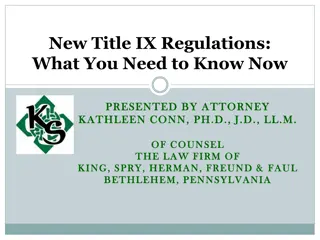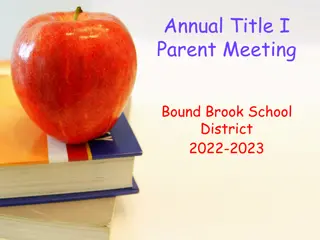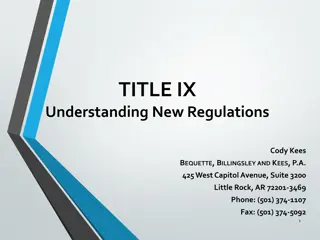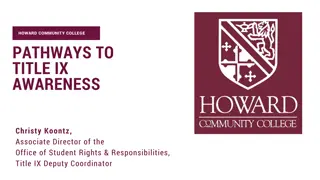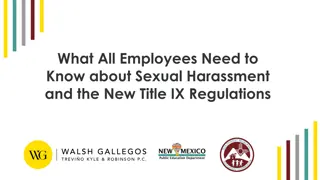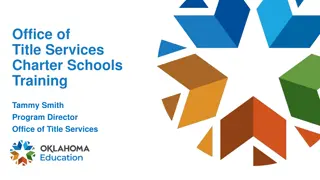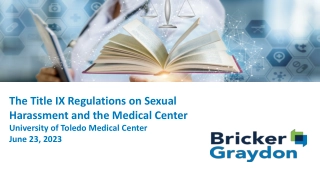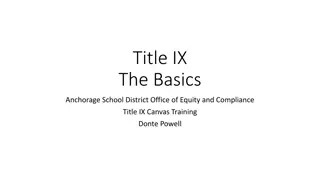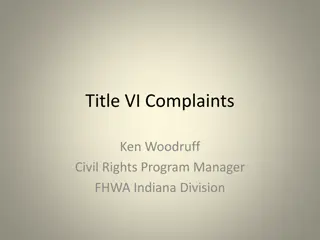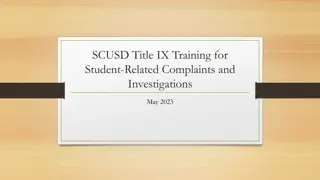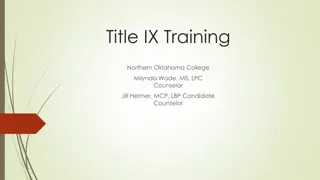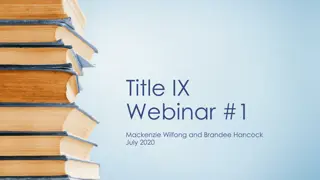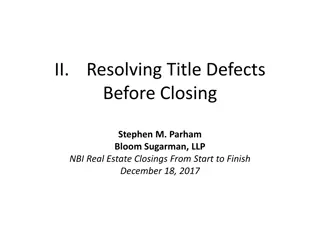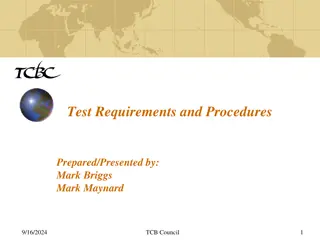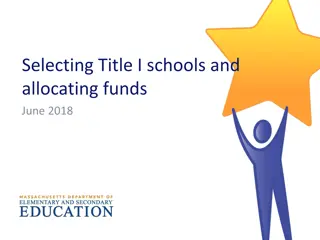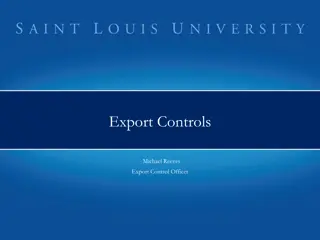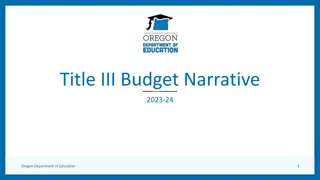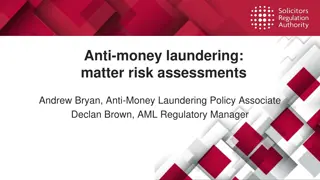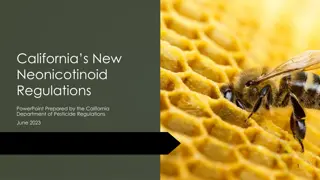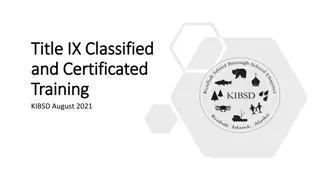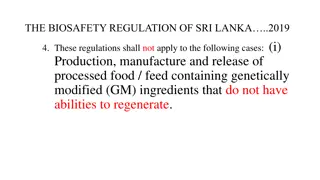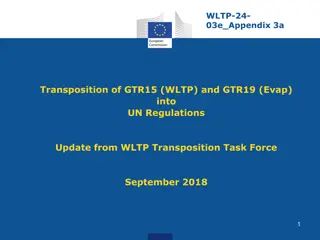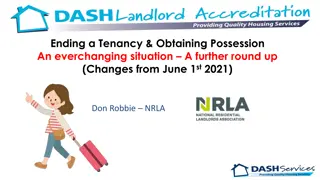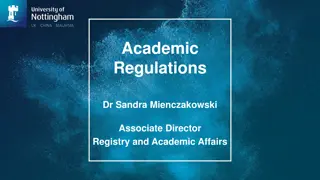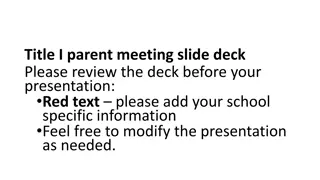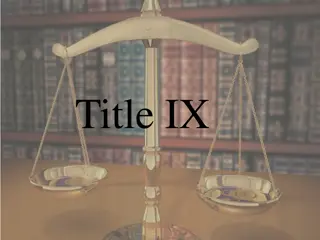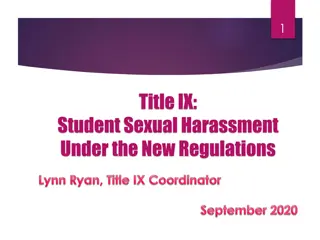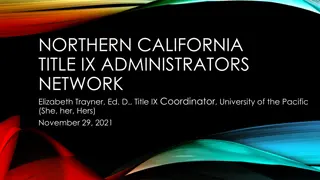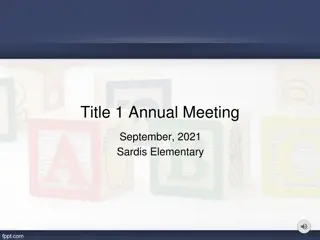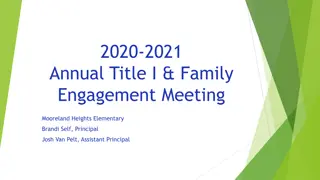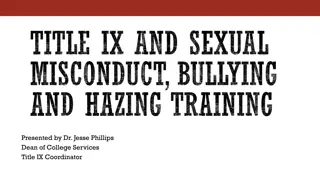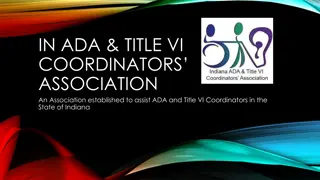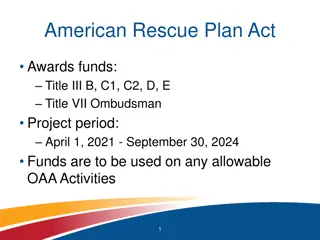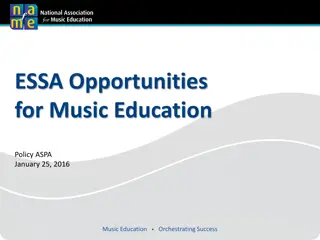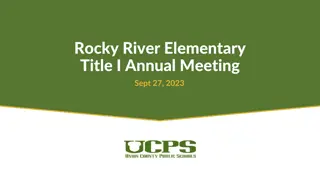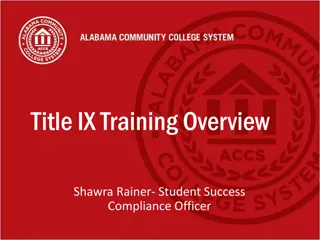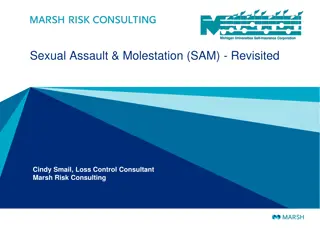Understanding Title IX Regulations and Procedures in Education
Title IX of the Education Amendments Act of 1972 ensures that no individual in the U.S. can be discriminated against on the basis of sex in any educational program or activity receiving Federal financial assistance. This content delves into the significance of Title IX, new regulations from 2011 to 2020, the definition of sexual harassment, and examples of sexual harassment. It highlights the roles of key contacts and the process involved in handling student-related complaints and investigations. The regulations emphasize increased due process for respondents and the importance of addressing sexual harassment promptly and effectively to maintain a safe educational environment.
Uploaded on Sep 16, 2024 | 0 Views
Download Presentation

Please find below an Image/Link to download the presentation.
The content on the website is provided AS IS for your information and personal use only. It may not be sold, licensed, or shared on other websites without obtaining consent from the author. Download presentation by click this link. If you encounter any issues during the download, it is possible that the publisher has removed the file from their server.
E N D
Presentation Transcript
SCUSD Title IX Training for Student-Related Complaints and Investigations November 2, 2021 November 9, 2021 November 17, 2021 3:30pm-4:30pm
Title IX Contacts Student Hearing and Placement Department Stephan Brown (Title IX Coordinator) Jessica Wharton (Lead Investigator) Legal Services Department Raoul Bozio (In-House Counsel) Alexa Hankard (Legal Analyst I)
What is Title IX? Title IX of the Education Amendments Act of 1972 No person in the United States shall, on the basis of sex, be excluded from participation in, be denied the benefits of, or be subjected to discrimination under any education program or activity receiving Federal financial assistance. District policies cover nondiscrimination/harassment and sexual harassment (BP and AR 5145.3 and 5145.7); recently updated AR 5145.7
New Title IX Regulations 2011 vs. 2020 Reasonably prompt timeframe Process now needs to be completed in a reasonably prompt timeframe Procedural requirements for due process Increased due process for respondent, including multiple opportunities to respond to allegations and finding Either the complainant or respondent can appeal the District s decision, but only the respondent can appeal the District s sanction
New Title IX Regulations 2011 vs. 2020 The definition of sexual harassment Unwelcome conduct determined by a reasonable person to be so severe, pervasive, and objectively offensive that it effectively denies a person equal access to the District s education program or activity Also includes sexual assault, dating violence, domestic violence, and stalking Actual knowledge for notice When any employee has notice of sexual harassment or allegations of sexual harassment Deliberate indifference standard
New Title IX Regulations 2011 vs. 2020 Sexual Harassment Definition Continued Sexual assault Dating violence Domestic violence Stalking
Examples of Sexual Harassment Unwelcome propositions Derogatory comments Sexual jokes or gestures Spreading sexual rumors Grabbing or touching Comments on an employee or student s body Sexual acts without consent or based on coercion
Title IX Jurisdiction 2020 Rule Allegations of sexual harassment fall under Title IX when: The conduct occurs against a person in the United States; The conduct occurs in an education program or activity over which the District exercised substantial control over both the respondent and the context in which the sexual harassment occurs; and The complainant was participating/attempting to participate in the educational program or activity at the time the complaint was filed.
Mahoney Area School District v. B.L. A freshman student who, while outside of school and using her own personal device, expressed in a Snapchat post her displeasure (using profanity) in not making the varsity cheer team The post was sent to only her private friends on Snapchat, and per that social media platform s functions, was deleted within 24 hours. Other students who saw the post turned over the screenshot to school officials, who then suspended the student from the junior varsity cheerleading team for the upcoming year. The student brought a lawsuit challenging her suspension from cheer as a violation of her First Amendment free speech rights.
Mahoney Principles Certain types of student expression occurring outside of the school environment may be regulated subject to the following principles: 1. When compared to on-campus speech, off-campus speech will normally fall within the zone of parental, rather than school-related, responsibility. 2. Schools off-campus speech regulation, together with on-campus speech regulation, would functionally permit schools to regulate a student s speech 24-hours a day, seven days a week a concept the court found constitutionally untenable. 3. Schools have a duty to protect expression, even unpopular expression, as a way to transmit the ideals necessary for our representative democracy.
Mahoney Conclusion Case By Case Basis The court concluded that the student s off-campus expression was beyond the school s authority to discipline for or otherwise regulate. The student made the offending posts outside of school hours, on a non-school device, at a non-school location; There was no reason to think the student s parents had delegated the school control over the student s behavior; The posts did not identify the school or any school staff; and The off-campus expression did not cause a substantial disruption to the educational environment or the extracurricular activity of the cheerleading squad.
Social Media How does Mahoney play a role? Are the texts made outside of school hours, on a non-school device, at a non-school location? Is there a reason to think the student s parents had delegated the school control over the student s behavior? Do the texts identify the school or any school staff? Do the texts cause a substantial disruption to the educational environment or the extracurricular activity? If the texts are made outside of school hours, on personal devices, and off-campus and there is no substantial impact on students education, extracurricular activities, or mental health, then the District most likely should not apply consequences. Nonetheless, the District may have an obligation to further investigate.
Key People and Terms Complainant Respondent Coordinator Investigator Decision-maker Appeals Officer Informal Resolution Officer Advisor
Title IX Specialist Responsibilities Know the Process/ Explain Process Formal Written Complaint vs. Report Keep Excellent Records Preliminary Investigation (Keep Notes) Likely Assist Actual Investigation Offer Supportive Measures
Informal Resolution Informal resolution is a process that does not involve a full investigation and adjudication and can only be offered when: A formal complaint is filed; The District has sent a notice about the allegations and the informal resolution process; A written informed that a determination has not yet been made; Both parties have provided voluntary, written consent to the process (and have been notified they can withdraw from the process as any time). Informal resolution cannot be used for allegations where an employee is alleged to have sexually harassed a student.
Complaint Formal Complaint v. Informal Report Formal Complaint: A document filed by a complainant (i.e., the student or the student s parent/guardian) or signed by the Title IX Coordinator alleging sexual harassment against a respondent and requesting that the District investigate the allegation. Informal Report: If no formal complaint is filed by the complainant, the Title IX Coordinator should assess whether to independently initiate a complaint based on a threat to safety.
Report of Suspected Harassment https://www.scusd.edu/post/title-ix-harassment-complaint-forms
Whenever In Doubt, Report Verbal report to CPS agent Complete written report Keep copy of written report We are all mandated reporters
Supportive Measures Supportive measures should be offered to the complainant or respondent before and after the filing of a formal complaint or where no formal complaint has been followed. Escort to class Change to class schedule Refer to counseling Safety plan No Contact Order Emergency Removal Use trauma-informed approach Non punitive
Investigation Send notice of investigation letters to both the complainant and the respondent. Investigation process includes interviewing witnesses and reviewing evidence. Investigation report should be prepared by the investigator and must summarize relevant evidence. Parties must be offered the opportunity to provide a written response to the investigation report.
Decision-Maker The decision-maker must allow parties the opportunity to submit written relevant questions for the other party/witnesses and ask those questions they deem relevant. The decision-maker must provide an explanation as to why a question was deemed irrelevant. The decision-maker must prepare the written determination.
Appeal Parties may appeal the written determination on the following bases: Procedural irregularity New evidence that was not reasonably available earlier Title IX personnel had a conflict of interest or bias Appeal Officer Doug Huscher, Assistant Superintendent Student Support Services


